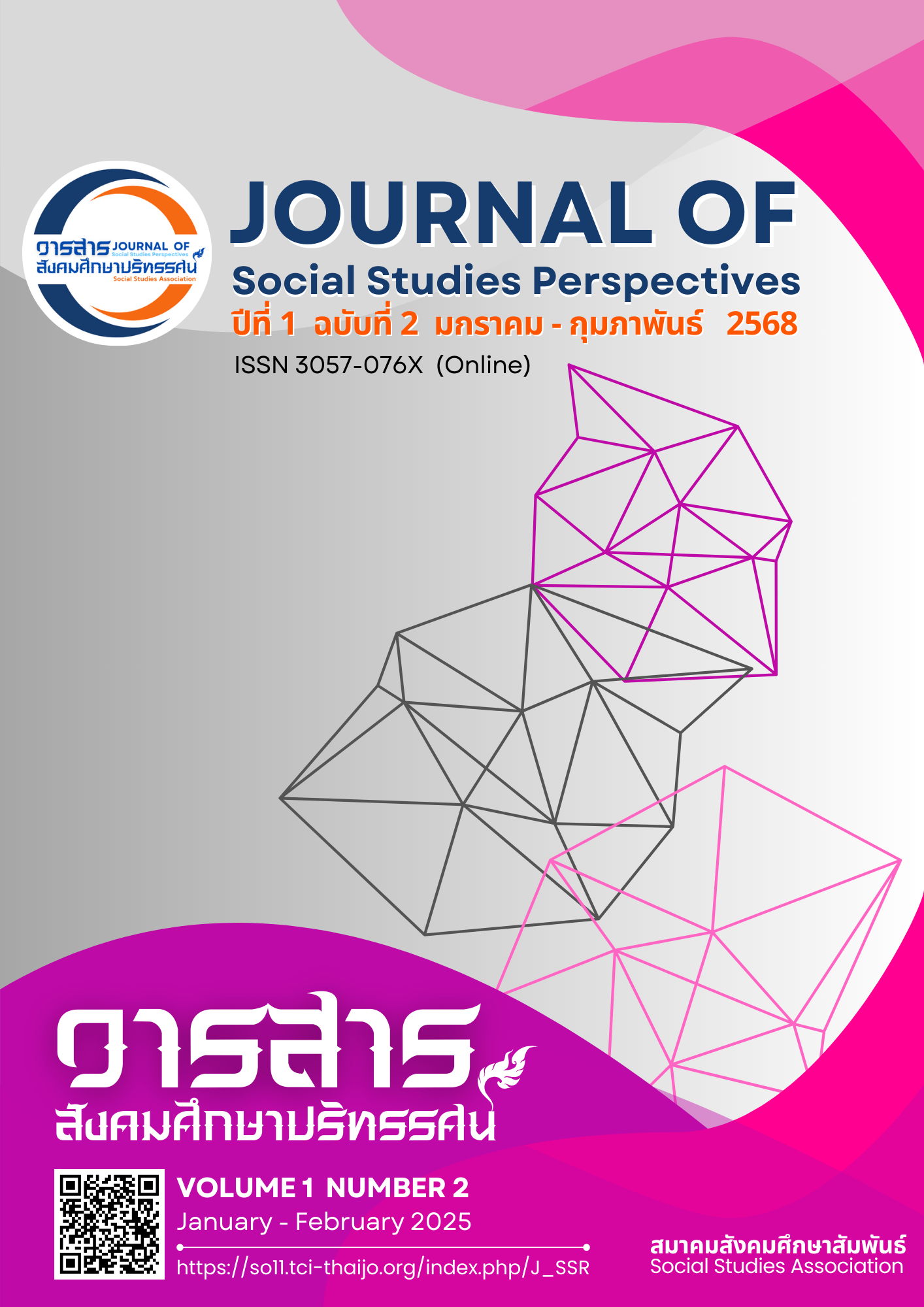SOCIAL STUDIES, RELIGION, AND CULTURE LEARNING AREA : CURRICULUM FOR LEARNING ACITIVITIES FROM THE ERA OF BANI WORLD TO THE NEXT NORMAL
DOI:
https://doi.org/10.64186/jsp1309Keywords:
Social Studies , Curriculum, Learning ActivitiesAbstract
Facing new challenges amidst the transition from the VUCA era to the BANI era, and from the New Normal to the Next Normal, the education sector must be aware of professional ethics in self-development while preparing to equip youth to handle these societal changes. This is especially important in social studies courses, which inherently involve human interactions. The author aims to present learning activities for teachers in the field of social studies, religion, and culture at the school level, which serves as the first gateway to further educational growth. The presentation is divided into five parts as follows 1)Introduction, 2) From Curriculum to Social Studies, Religion, and Culture Education, 3) Perspectives on Teaching Social Studies, Religion, and Culture in Other Countries, 4) Organizing Learning Activities Integrated with Social Studies, Religion, and Culture Courses, 5) Conclusion
References
Armstrong, D. G. (1989). Developing and documenting the curriculum. Needham Heights, MA: Allyn and Bacon.
Beane, J. A. (1993). A middle school curriculum: From rhetoric to reality (2nd ed.). Columbus, OH: National Middle School Association.
Bloom, B. S. (1956). Taxonomy of educational objectives, handbook: The cognitive domain. New York, NY: David McKay.
Bullock, S. J. (1988). Future and present trends of navigation and positioning techniques in exploration geophysics. Geophysical Journal, 92(3), 521.
Callon, M. (1986a). The sociology of an actor-network: The case of the electric vehicle. In M. Callon, J. Law, & A. Rip (Eds.), Mapping the dynamics of science and technology (pp.19–34). London, England: Macmillan.
Cascio, J. (2020). Facing the age of chaos. Medium. Retrieved from https://medium.com/@cascio/facing-the-age-of-chaos-b00687b1f51d
Chanaradee, N., Nodon, & Warit. (2020). Singapore’s social studies curriculum. Facebook. Retrieved from https://www.facebook.com/ThaiTeacherEd
Chuerattanapong, J. (1996). Curriculum development: Principles and practices. Bangkok: Aline Press. [in Thai]
Delors, J. (1996). Learning: The treasure within; report to UNESCO of the International Commission on Education for the Twenty-first Century (highlights). Paris, France: UNESCO.
Doll, W. (1993). A post-modern perspective on curriculum. New York, NY: Teachers College Press.
Fogarty, R. (1991). How to integrate the curricula. Palatine, IL: IRI/Skylight Publishing.
Gagne, R. M. (1985). The conditions of learning (4th ed.). New York, NY: Holt, Rinehart and Winston.
Government. (2014). National curriculum for basic schools and upper secondary schools. Retrieved from https://www.riigiteataja.ee/en/eli/524092014014/consolide
Halcrow, S. E., Tayles, N., & King, C. (2016). Infant and child health in prehistoric Southeast Asia. In M. Oxenham & B. Buckley (Eds.), Bioarchaeology of Southeast Asia and the Pacific (pp. 158–186). Cambridge, England: Cambridge University Press.
Hargreaves, A. (1995). Development and desire. In T. Gusky & M. Huberman (Eds.), Professional development in education (pp. 9–35). Milton Keynes, England: Open University Press.
Humphreys, A., Post, T., & Ellis, A. (1981). Interdisciplinary methods: A thematic approach. Santa Monica, CA: Goodyear Publishing Company.
Jacobs, H. H. (1989). Interdisciplinary curriculum: Design and implementation. Alexandria, VA: Association for Supervision and Curriculum Development.
Latour, B. (1988). The pasteurisation of France. Cambridge, MA: Harvard University Press.
Nattaya, P. (2003). Social studies: The era of standards. Rojchanaprinting Publisher. [in Thai]
OpenAI. (2024). The New Zealand curriculum. ChatGPT (December 16 version). Retrieved from https://chatgpt.com
Turok, M. (2008). Breaking social confinement: An analysis of eighteenth-century women in the French economy. Journal of Undergraduate Research at Minnesota State University, Mankato, 8, Article 15.
Tyler, R. W. (1949). Basic principles of curriculum and instruction. Chicago, IL: University of Chicago Press.
Wiphaphan, P., & Wiphada, P. (2023). Learning management social studies in the 21st century. Chulalongkorn University Printing House. [in Thai]
Downloads
Published
How to Cite
Issue
Section
Categories
License
Copyright (c) 2025 Journal of social studies perspectives

This work is licensed under a Creative Commons Attribution-NonCommercial-NoDerivatives 4.0 International License.
The article is published under the Creative Commons Attribution-NonCommercial-NoDerivatives 4.0 International (CC BY-NC-ND 4.0) license, which allows others to share the article while giving appropriate credit to the author. It prohibits the use of the article for commercial purposes or the creation of derivative works. Any other reuse or reproduction requires permission from the journal.










